






December 2014
At first glance, the gear box of the M00A
no. 126 was intact and should not be worked up actually.
However, the oil seals at the output shaft were obviously untight
and oil exuded. So a dismounting was inevitable. It was found
that the motor-side driver was totally worn and not fixed on the
drive shaft and its conical seat had to be repaired. This meant
a new production of - fortunately short - shaft and the seat in
the driver disk by a friendly mechanic company. In addition, it
was necessary to replace all bearings in the gearbox, as they
were all worn too.






November 2014
Parallel to the works at her younger sister
even those on the L180 no. 1361 go on. The LD2
no. 5863 is to be considered in terms of weight and performance
as a successor to the L180, which is emphasized by the lying engine,
which was very popular at the early mining locos. The benzol loco
had a protective casing around the drive sprocket of the jackshaft
originally. Unfortunately only the mounting brackets remained,
so that the form had to be redesigned, as well as in the spare
parts list was no representation of it. Without this case there
is a risk of damaging the gears by picked up stones or metal parts
from the track .
The wooden (oak) buffer inserts
were long time ready for mount and now fitted, the tow hooks too.
The fitting springs are in progress. The circumferential, strong
metal strips of the buffers are made of of spring steel and struggled
successfully all tries of bagging with the 3 ton-jack.




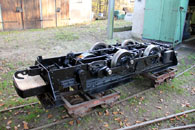
October 2014
Thanks to the active help of a hobby friend
the frame and the axes of the LD2 no. 6331 are painted
and now ready for assembling. Because of the new springs there
is now enough space between the whieels an the frame for the exaust
pipe. The next step now can be the refurbishing of the engine-gearbox-block.




August 2014
The wheel rims of the LD2 no.
6331 have been build-up welded and turned, so the profiles
enable a correct working of the locomotive on the track. The exhaust
gas scrubber must be re-fixed to overcome previous botch. The
sand-blasted parts show many blowholes that need to be filled
before painting.

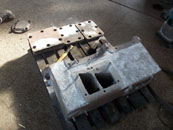
July 2014
Since 2001 is an article on the website
of Mauro
Bottegal about the surviving locomotives of the gravel railway
in Carturo (PD). A site visit at the time showed four under a
large shed roof parked machines, the RL2 no. 3391,
the RL4 no. 20028 and LD2 no. 10387 of
O&K as well as a locomotive of the American manufacturer Whitcomb.
Like Mauro wrote the state was quite good thanks to the roof,
despite obvious long shut-down. The owners, two very old brothers,
couldn’t get contacted. But at every journey in the region
during the next following years a visit to the machines was made,
however there was no changes except for a decline of the buildings.
Three years ago, a chance offered the first personal contact with
the current owner, who said that nothing is to sell except an
old digger. The key hint came by a years old post in an Italian
web forum, referred to the purchase of a Decauville loco. The
added photo in the post showed the RL2, in Carturo yet.
So it was urgent necessary to check how it looks there! Fortunately,
not the RL2, but the Whitcomb had been sold.
But that meant that the owner probably now considered to sell
the locomotives. By another lucky circumstance, it was possible
to find out an English speaking young man in a group of residents,
who was able to get the phone number of the owner. With the friendly
help by phone of a native speaker it could be made sure that the
"Montanias" came up for sale. The rest was easy to manage
unless the problem to order an empty truck, immediately before
the start of the summer holidays in Italy.
The loading was done with the help a local crane company , probably
one of the smartest from across the region, with a small, agile
and strong (22t) "magic crane".
However, it got stuck at first on a wet meadow (it had recently
rained properly), just like the truck, which should pull it out.
But there was still the big tractor that was supposed to haul
the locomotives from the dilapidated shed but didn’t have
the slightest chance.
So the locomotives looked before starting
of the works. They seemed to wait for the awake kissing. Sorry,
no princes were present. However, three side panels have been
lost in recent years, adjacent to the beautiful, large cooler
of the RL2. The front panel of the RL2 and a side
plate of the RL4 were missing already in 2001.

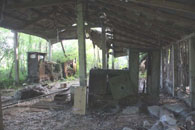
With difficulty the growth of the
recent decades has to be removed.
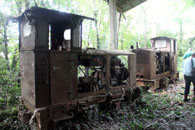
Now, the crane can lift and drag,
getting bit by bit with the telescope. With the help of the wheels
he wasn't able to make it.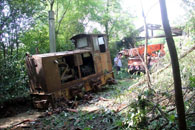
And at the end of the second, crooked
shed he can lift the locomotive. The 8t the RL4 didn't
seem to be a burden for the crane. The shed threatened to collapse
all the time, but could not be pushed aside for the action. Then
the bulidung lease would have been lost for...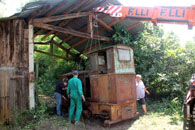
A kind of procession was the way to
the truck. Finally, someone had to keep the locomotive on the
"track". For the loading the crana stands on the same
place and the truck moved backwards.For the observer a confusing
relative movement.
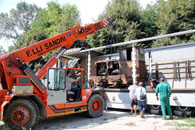
Now
the RL2 could by lifted the same kind whereat it lent risky
and left a deep furrow in the soft sand. But in the end, she was
hooked.

The
LD2 had to be brought "outside the box" to reach
the "main line", no problem for the crane with the light
locomotive. Compared to its big sisters it is almost a toy. By
the way, the head of the crane team was, due to his technique,
of respectable figure. And finally, a pure "Montania"
loaded truck appeared. He was later completed with a MD2,
for which the necessary space was left.

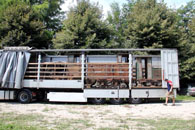
The locomotives reemaind under the
shed since the year 1968. While the RL2 and LD2
complete the own collection, the RL4 goes to a fellow collector
in Thuringia.
At once with the
Carturo locos another Montania locomotive was acquired in Italy,
which once was in duty for a construction company. This is - so
far known - the last built machine of the type MD2 from
1963, still equipped with the original engine (two-cylinder in
line). It is factory fitted with an electrical system and starter
and mounted in the workshop Sesto San Giovanni, near Milan. Obviously
it had from the beginning a red finish, as used by O&K later
for the construction machines. The loading with a forklift was'nt
without problems, so some volunteers had to support with their
own weight. With this fourth locomotive the truck was fully utilized
with 23 tons.

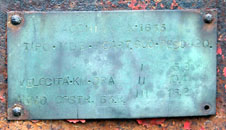
April 2014
The works on the frame of the M00A
no. 126 go ahead, so that they will be back on their "feet"
soon, after finally painting the bottom. Previously, the completely
broken springs are changed by new ones and the missing weights
on the left side are replaced. One of the two weights under the
footplate was re-mounted and all buffer screws were exchanged.
During the last operation of the locomotive the mechanics obviously
believed that casting buffers could be welded, a mistake. The
remaining weldseams have to be removed by grinding. The exhaust
wash box was apparently used without water, but filled for better
sound attenuation with old, crumpled cylinder head gaskets.


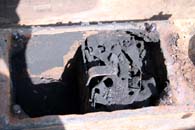
February 2014
The LD2 no. 6331 in mining design
will be restored together with a similar loco, owned by a friend.
So it will be easier to copy missing parts of one of the locos
after the existing parts of the other. The result will be two
nearly identic locos with only few differences. The decomposition
showed a good substance of the machine despite of some superficial
damage and considerable pitting. So the liner and the bearing
of the motor and the axle bearings are perfectly. , However, only
remnants of the suspension springs exists and the radiator needs
a new gauze. The element of the injection pump has to be replaced
but the nozzle insert could be refurbished. The cooling water
pump was broken and all internal parts except the paddle had to
be rebuilt. The axles have to be overlay welded and turned. The
metal parts of the hood must be new built widely. However, the
rareness of the loco justifies the effort.






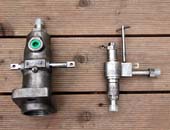
January 2014
During the Christmas holidays the hint
of a light railway friend offered the opportunity to buy MD3
no. 11709 from the Swedish Decauville railway museum at Frövi.
The locomotive has no engine, but several years ago this was sold
as a spare part to the Feldbahnmuseum Herrenleite, because it's
cylinder heads were lost in Sweden. Luckily in Pirna the engine
was not needed because the local MD3 could be restored without
it's help. But the required cylinder heads are already existing
and now it is possible to complete the loco. When attempting to
mount a chanded engine, the hood was removed in Frövi and
not completed. However, all housing parts incl. cooler are remaining.
The substance of the locomotive is good at first glance, more
details will be seen during disassembly.




